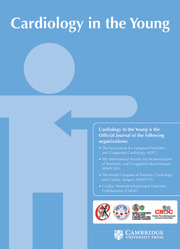No CrossRef data available.
Article contents
Coronary stent embolization during percutaneous ductal stenting in a premature baby: history of a successful stent retrieval with “indirect stent snary” technique
Published online by Cambridge University Press: 07 February 2025
Abstract
Patent ductal arteriosus stenting is an alternative procedure in patients with pulmonary-ductal-dependent circulation. Stent embolization is one of the major acute complications of ductal stenting procedure. We describe the case of a stent embolization into the abdominal aorta during the deployment of ductal stent in a premature low-weight infant (1.850 kg), affected by critical pulmonary stenosis and duct-dependent pulmonary circulation. The stent was successfully retrieved through a 4F Flexor catheter without vascular complication by using a new approach.
- Type
- Brief Report
- Information
- Copyright
- © The Author(s), 2025. Published by Cambridge University Press



